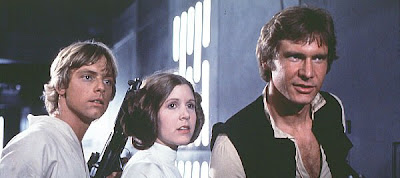
Given all the prequels, sequels and merchandising it has engendered, it is sometimes a bit strange to realize that Star Wars (1977) has been the #2 movie of all time, rather than the #1 movie of all time, for most of its existence. And today, it will lose even that distinction, as it becomes the latest film to fall behind The Dark Knight‘s record-setting run at the box office.
A bit of history:
At the time Star Wars came out, the #1 movie of all time was Jaws (1975), directed only a couple years earlier by George Lucas’s friend, Steven Spielberg. Jaws is now estimated to have earned about $260 million, but Star Wars quickly passed that amount, grossing about $323 million over its first five years; not only was it a smash in its initial release, but it kept drawing audiences as the sequels came out and the original film was re-issued to keep the back-story fresh in audiences’ minds. (This was before home video had really taken off; Star Wars itself did not come out on VHS until 1982.)
Star Wars was itself surpassed only a few years later, though, by another Spielberg film, E.T. the Extra-terrestrial (1982), which grossed $359 million in its initial release and another $40 million when it was re-issued in 1985. (That film did not come out on VHS until 1988.)
For the next decade or so, that was how things remained at the top of the chart: E.T. at #1, Star Wars at #2.
Then, in the 1990s, a couple films came between them. First, Jurassic Park (1993), also directed by Spielberg, gave audiences their first taste of sustained digital creature animation, and grossed a handy $357 million as a result. Then, Forrest Gump (1994) — directed by a former protege of Spielberg’s named Robert Zemeckis — inserted Tom Hanks into archival news footage and rode a wave of Baby Boomer nostalgia to $329 million.
So now Star Wars was down at #4. But in January 1997, it rebounded. After more than a decade without any new Star Wars films, and after an entire generation had grown up watching the original trilogy on the small screen, Lucas spiffed up the special effects and re-issued the original trilogy on the big screen. The “special edition” of Star Wars alone grossed $138 million, making it the 8th-biggest hit of 1997; and, combined with the film’s earlier earnings, the new earnings gave the film a new total of $461 million, vaulting it right back to the top of the list.
It didn’t stay at the top for long, though. At the end of the year, James Cameron released Titanic (1997), which didn’t have a particularly strong opening weekend, but it did stay at the top of the weekly box-office charts for a whopping fifteen weeks, and when all was said and done, the film had grossed an unprecedented $600 million. And so Star Wars was back down at #2.
And there it has stayed — until now.
Can Star Wars rise to the top again some day? I’m not so sure.
The 20th anniversary re-issue in 1997 was fueled, in part, by a hunger for the franchise which was, itself, motivated by the fact that Star Wars had been relatively inaccessible for so long. Yes, everyone had the original trilogy on VHS, but home-entertainment systems weren’t very impressive in those days. Plus, of course, there was an entire generation of Echo Boomers — the people who made Home Alone (1990) a hit when they were kids, the people who made Scream (1996) and Titanic hits when they were teens — who had never experienced these movies on the big screen in the first place.
But the potential, I suspect, just isn’t there for anything similar to happen for, say, the film’s 40th anniversary in 2017, and not just because the demographics and the home-video options have changed so dramatically in the intervening years. Over the past decade, Lucas has released four new Star Wars movies — including this weekend’s widely-panned The Clone Wars — and he has tampered with the original trilogy repeatedly. What’s more, he has promised to keep on releasing new material on TV, and the overall effect of all this revisionism and overexposure has been to drain Star Wars fans of their enthusiasm for the franchise.
So, Star Wars has slipped back down to #3. And it will probably not rise back up the chart this time.
Still, who could have imagined that the day would come when neither of the top two films of all time would have Lucas or Spielberg at the helm? Star Wars is now down at #3, E.T. is down at #5 (despite earning an extra $35 million when it was re-issued in 2002; otherwise it would be down at #8), Jurassic Park is down at #13, Forrest Gump is down at #17, and Jaws is down at #42. Life goes on, ticket prices rise, and milestones that once seemed impressive are now just better business than usual.
Incidentally, all of these figures relate to the domestic chart, and none of them take inflation into account.
When you look at the worldwide chart, Star Wars: Episode I – The Phantom Menace (1999) is Lucas’s biggest hit of all time, at #8, and Jurassic Park is Spielberg’s biggest hit, at #10. The rest of the worldwide top ten is occupied by two Lord of the Rings films, two Harry Potter films, two Pirates of the Caribbean sequels, Shrek 2 and Titanic.
And when you adjust the domestic chart for inflation, Star Wars is #2 again — behind Gone with the Wind (1939).












